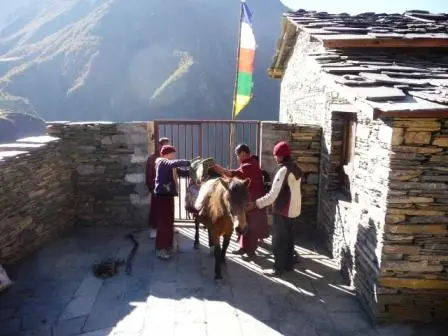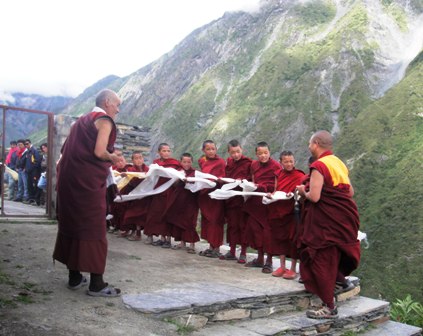Tsum Communities
Rachen Nunnery and Mu Gompa

High in the Himalayan ranges, near the majestic Ganesh Mountain, is a hidden valley called Tsum.
Tsum is a very old Buddhist region, close to Tibet, with a long history of Dharma practice, and blessed by meditators, such as Padmasambhava, Milarepa and many others. It is highly conducive place for practice and a special place to attain liberation in this lifetime. Its many small villages are clustered along the river raging down the steep valley. Amongst the settlements are Rachen Nunnery and Mu Gompa.
Young nuns in English class
Rachen Nunnery and Mu Gompa were established in 1936 by Drupa Rinpoche, a Bhutanese lama who meditated in the caves dotted along the rim of the valley. His incarnation, the present Drupa Rinpoche requested Lama Zopa Rinpoche in 2005 to take care of the two sangha communities. At that time, the monks and nuns were living in extremely dire circumstances, sleeping on the bare floor, and having very little to eat. Accepting the request, Lama Zopa Rinpoche asked Kopan Monastery to take over the administration of the two communities.

Read more about the Tsum Monastic Communities here.
Rachen Nunnery is home to eighty young and old nuns, meditating, praying and studying. Here, the transformation has been amazing. In the beginning the water for daily cooking and washing had to be taken from the river. Now water is piped from a spring high up near a glacial lake, ensuring a water supply even in winter. Both communities previously had no electricity, so after dark everybody had to rely on a candle or butter lamp. They now have solar lights, solar shower and even low wattage electricity from a small hydroelectric plant nearby. A small vegetable garden has been set up, under plastic covers, to protect it from the cold winds andnight frosts.
There is a proper school in the nunnery with classes in English, simple math and shome scien, with a qualified geshe teaching Tibetan and Buddhist philosophy. The older nuns, some of who were there when Geshe Lama Konchok was abbot, in the 1970s, are living in retreat in their own area.

A resident Tibetan doctor is taking care of health problems, also for the local community. New warm and spacious rooms, a kitchen, dining room and classrooms have been constructed in the past few years. The nunnery provides food, medical care, and education for all. The medical section of the nunnery is very popular with the local population - in Tsum, health centers are still very few and most often hours of walking away.
Mu Gompa at 4000 meters sits on top of a hill amidst towering peaks in spectacular surroundings. It is very isolated, with the next settlement several hours walk away. It is a wonderful place, deep silence all around, the perfect place for meditation. Around 20 monks live, study and practice here. The ounger ones go to classes with the resident geshe, particpate in pujas and ceremonies, and help with the daily chores. The old monks, and there are several ones who have been there for 40 years or more, live in retreat, and guide the younger monks in their practice.

Mu gompa - coming back from shopping in Tibet
The wind whistles continuously through the eaves of the buildings. Here, like in all of Tsum, the winters are long and very hard. This is not an easy environment to live in, with hardly any heating, and regular food supply depending on the weather conditions. Much work is needed just to provide the neccessities fordaily survival. Food is scarce. Only potatoes, barley, millet and mustard seed (used to make cooking oil) grow at this high altitude, and in the short summer season a few green vegetables survive in protected places. When the summer rains fail, famine is a constant threat.
Most supplies have to be brought over a long distance: some come on yak caravans from Tibet, a two day horse ride away; some supplies come from the lower area of Gorkha, which is a five day walk with pack horses. High transport costs make everything very expensive - food, clothing, medicines, and building materials.
Much help is needed for these two communities. Kopan is continuing to initiate projects to improve the quality of life there.


How you can help Tsum
Make a donations towards these needs
- Daily Needs - food, robes,warm clothing
- Education – wages for teachers, books, pencils,.
- Medical care - health camps, medical supplies, wages for a full time nurse
- General donation – improvments and maintenance, emergency health care